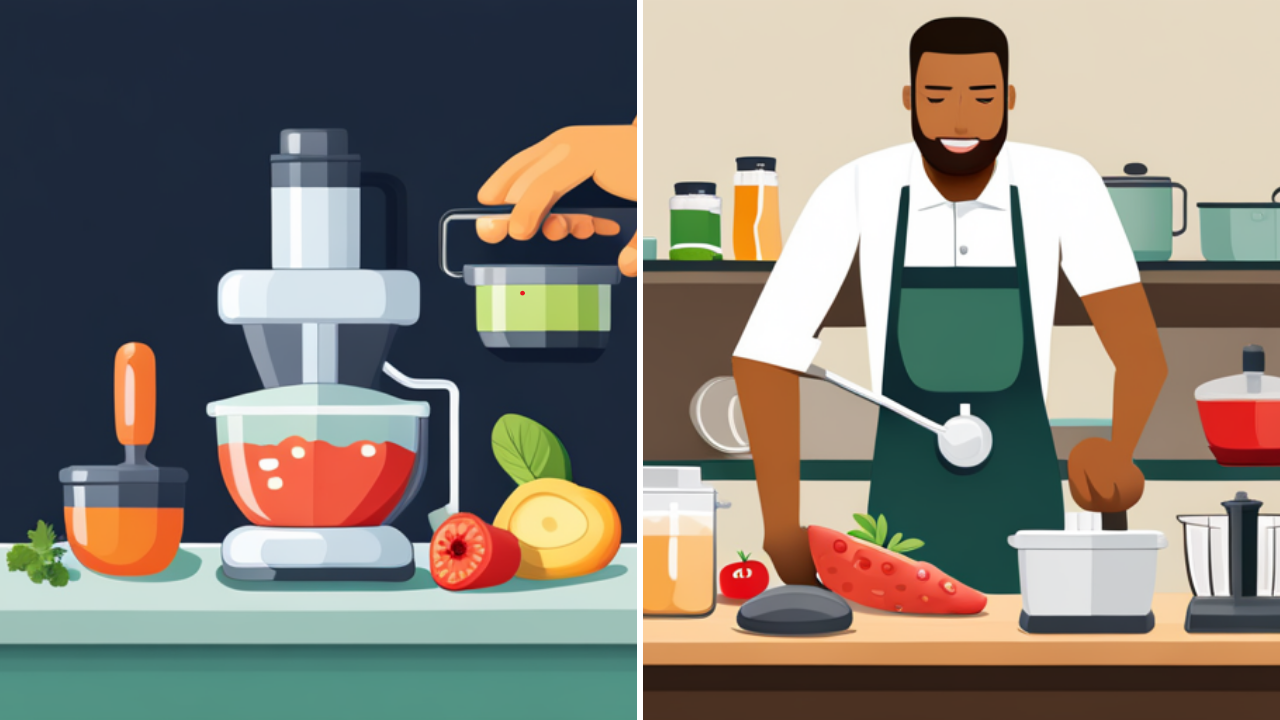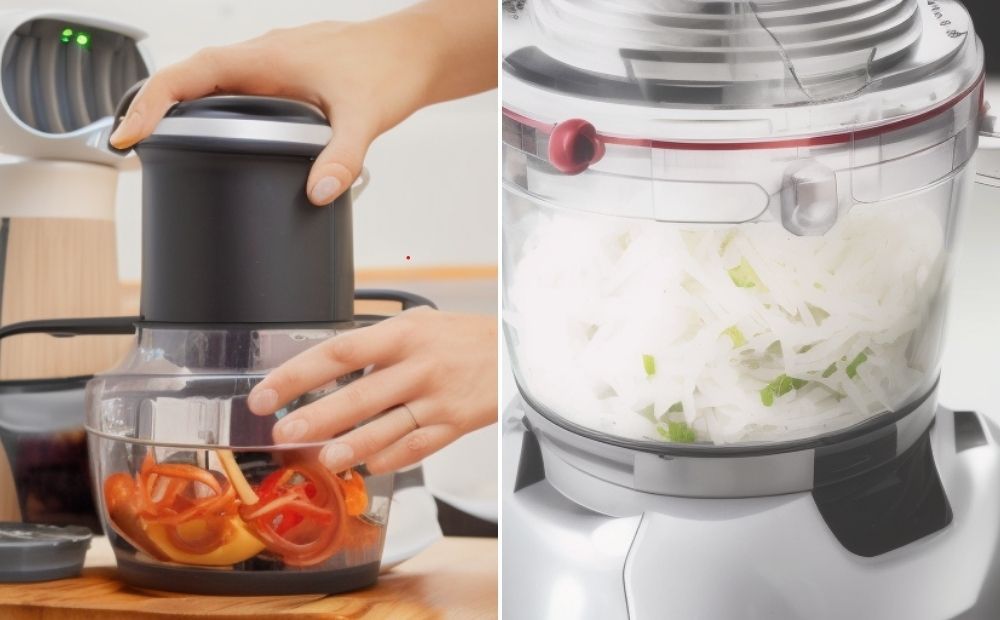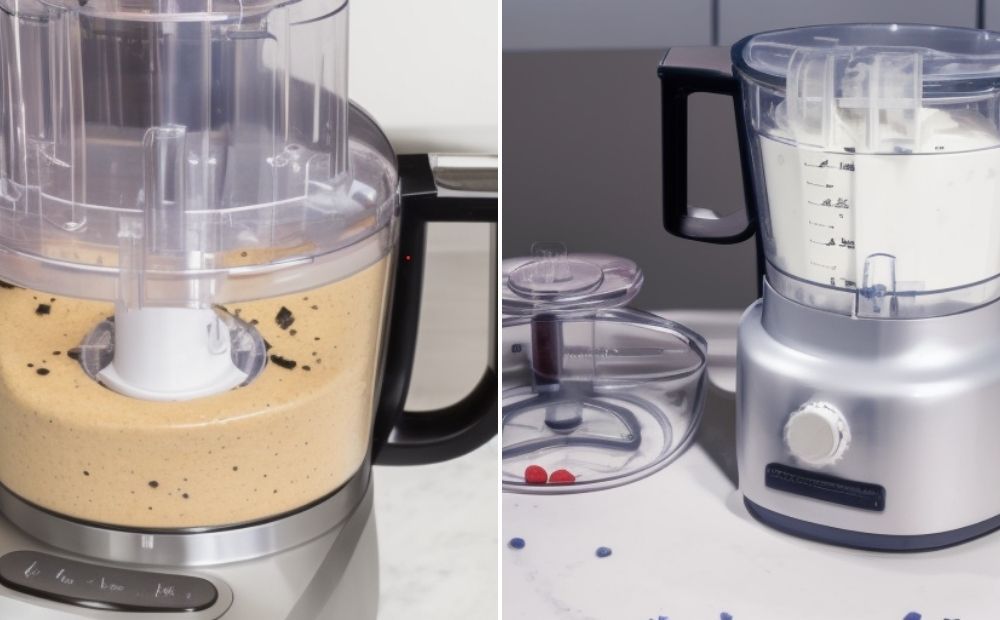When it comes to kitchen appliances, the terms "food chopper" and "food processor" are often used interchangeably.
However, while they may seem similar at first glance, these two devices serve distinct purposes and offer different functionalities.
In this article, we'll delve into the key differences between food choppers vs food processors, helping you decide which one is right for your culinary needs.
Short Summary
- Food processors are versatile with multiple blades and functions.
- Food choppers are compact and ideal for smaller tasks.
- Processors can handle larger recipes, while choppers are for quick tasks.
- Both have their unique advantages depending on the cooking task.
The modern kitchen is replete with gadgets and appliances designed to make food preparation easier and more efficient.
Among these tools, food choppers and food processors stand out as essential devices for chopping, slicing, and mixing ingredients. But what sets them apart?

Food Choppers
These are compact kitchen tools, primarily designed for chopping foods into smaller pieces. They're perfect for quick tasks like dicing onions, chopping nuts, or making small batches of salsa.
Their smaller size makes them easy to store and clean.
Food Processors
A food processor is a versatile appliance equipped with multiple blades and settings. It can handle a range of tasks, from slicing vegetables and kneading dough to pureeing soups.
Due to its multifunctional nature, a food processor is often larger than a food chopper and can process larger quantities of food at once.
For a detailed look at the top food processors of 2023, check out this comprehensive guide by Wirecutter.
In essence, while both food choppers and food processors can chop food, the latter offers more versatility and is suitable for more complex culinary tasks.
Choosing between the two boils down to your specific needs and the recipes you frequently prepare.

Food chopper vs food processor
Understanding Food Processors
What is a Food Processor?
A food processor is a versatile kitchen appliance designed to facilitate repetitive tasks in the preparation of food. Equipped with interchangeable blades and disks, it offers a wide range of functions, including:
- Chopping and mincing vegetables, fruits, and meats.
- Slicing and shredding ingredients like cucumbers, carrots, and cheese.
- Kneading bread dough, for bread, pastries, and other baked goods.
- Mixing and blending ingredients for recipes like hummus, pesto, and smoothies.
- Pureeing foods to create soups, sauces, and baby food.
Its multifunctional capabilities make it an invaluable tool for both amateur cooks and professional chefs.
By reducing manual labor and time, a food processor ensures consistent results and enhances the overall cooking experience.
Capabilities of Food Processors
Food processors are renowned for their multifunctional capabilities, making them a staple in many kitchens. Here are some of the primary functions they can perform:
- Chopping: Whether it's vegetables, fruits, or meats, a food processor can chop them to your desired consistency.
- Mixing: From cake batters to salad dressings, it ensures ingredients are well-combined.
- Puréeing: Ideal for making smooth soups, sauces, and baby foods.
- Whipping: Create whipped cream, meringues, and other airy mixtures with ease.
- Emulsifying: Perfect for making stable emulsions like mayonnaise or vinaigrettes.
- Slicing: Achieve uniform slices of vegetables or fruits, ideal for salads and garnishes.
- Shredding: Grate cheese, vegetables, or even chocolate without manual effort.
- Dicing: Get uniform dices, especially beneficial for recipes that require consistent sizes for even cooking.
These capabilities highlight the difference between a food and processor's role in ensuring that food preparation is efficient, consistent, and less labor-intensive.
Benefits of Using a Food Processor
The advantages of using a food processor extend beyond its multifunctionality:
- Larger Capacity: Most food processors come with sizeable food processor bowls, allowing users to process larger batches of ingredients at once.
- Versatility: With various attachments and settings, it can handle a wide range of culinary tasks.
- Powerful Motors: This ensures that even tough ingredients like nuts or dough can be processed smoothly.
- Accommodating Larger Ingredients: With a wide feed tube, users can insert bigger pieces, reducing the need for pre-chopping.
In essence, a food processor is not just a kitchen appliance; it's an investment in enhancing the quality and efficiency of your culinary endeavors.
Advanced Features of Food Processors
As technology evolves, modern food processors typically come equipped with a range of advanced features that further enhance their utility and efficiency in the kitchen.
Here are some of the standout advanced features:
- Continuous Feed Food Processor: This feature allows users to keep adding ingredients into the processor without needing to stop and empty the bowl. It's especially useful for tasks like slicing or shredding large quantities of vegetables or cheese, ensuring a seamless and uninterrupted workflow.
- Multiple Feed Tubes: Some high-end food processors come with multiple feed tubes of varying sizes. This design ensures that both larger and smaller ingredients can be added simultaneously, optimizing the processing time and reducing the need for pre-cutting.
- Specific Techniques: Advanced models often have settings that cater to specific culinary techniques. For instance, some processors have a "pulse" function that provides short bursts of power, ideal for roughly chopping ingredients or incorporating air into mixtures. Others might have dedicated settings for kneading dough, ensuring it's done to perfection without overworking.
These advanced features, while not always essential for every user, can significantly enhance the user experience, especially for those who frequently cook or enjoy experimenting with diverse recipes.
Investing in a food processor with these capabilities ensures precision, efficiency, and versatility in the kitchen.

Food processors
Understanding Food Choppers
What is a Food Chopper?
A food chopper is a compact kitchen tool designed specifically to chop and mince food ingredients into smaller pieces.
Unlike the multifunctional food processor, a food chopper primarily focuses on breaking down ingredients, making it an ideal choice for quick and smaller tasks of food prep.
Here are its primary functions:
- Chopping: Efficiently breaks down vegetables, fruits, nuts, and even certain meats into smaller, uniform pieces.
- Mincing: Perfect for ingredients like garlic, herbs, and onions, ensuring they're finely minced for recipes.
- Puréeing Small Batches: While not as powerful as food processors, some choppers can purée softer ingredients for sauces or baby foods.
In essence, a food chopper is a handy tool for those who need to quickly chop ingredients without the need for larger, more complex appliances.
Types of Food Choppers
Food choppers can be broadly categorized into:
- Manual Choppers: These are hand-operated and often come with a pulling mechanism or a push-down handle. They don't require electricity and are portable, making them perfect for outdoor cooking or travel.
- Electric Choppers: Powered by electricity, these choppers offer more consistent results and can handle tougher ingredients. They usually come with a button or switch for operation and are more suitable for regular kitchen use.
While both types serve the primary purpose of chopping, the choice between manual and electric depends on the user's frequency of use, convenience, and specific needs.
Benefits of Using a Food Chopper
Food choppers, with their simplicity and efficiency, bring several benefits to the table:
- Compact Size: One of the standout features of food choppers is their compact design. This makes them easy to store, even in kitchens where space is at a premium.
- Ideal for Small Tasks: Not every culinary task requires a large appliance. For quick chops or minces, a food chopper is more than sufficient. It's perfect for preparing ingredients for a single meal or a small batch of a recipe.
- Convenience: With straightforward operation, food choppers reduce the manual effort of cutting, especially for those who might find using knives challenging. Plus, the cleanup is often quicker compared to larger appliances.
Common Uses of Food Choppers
While food choppers are primarily known for chopping, their utility extends to various culinary tasks:
- Chopping Nuts: Achieve the perfect consistency, whether you're preparing toppings for desserts or adding them to salads.
- Making Dressings: Blend herbs, oils, and other ingredients to create fresh dressings for salads and dishes.
- Puréeing: While they might not handle large batches, food choppers can purée softer ingredients efficiently.
- Preparing Baby Food: Create small batches of fresh, homemade baby food by puréeing fruits and vegetables.
- Grinding Meat: Some choppers can handle meat, allowing users to prepare ground meat for patties or meatballs.
- Creating Dips and Salsas: Blend tomatoes, onions, herbs, and spices to make delicious dips and salsas.
In essence, a food chopper, though compact, is versatile enough to handle a range of tasks, making it a valuable addition to any kitchen.
Food Processor vs Chopper | Which One Will be Better? - Kitchen Gadgets Zone
Conclusion
In our exploration of a food processor vs food chopper, we've uncovered their distinct functionalities and benefits.
While larger food processors themselves are versatile appliances capable of handling a multitude of tasks from slicing to kneading, food choppers excel in quick, smaller tasks, offering convenience in a compact design.
Both have their unique places in the kitchen, catering to different culinary needs.
IncredibleRatings Recommendation: For those who frequently engage in complex cooking tasks or prepare meals for larger families, investing in a food processor is a wise choice.
However, if you're looking for a tool for quick chops or have limited kitchen space, a food chopper is an invaluable asset.
Ultimately, understanding your cooking habits and needs will guide you to the right meal prep decision.
Happy Chopping!!










